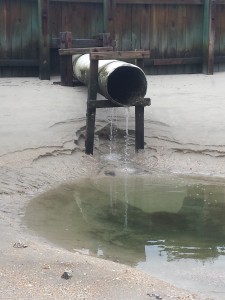Stormwater Runoff

Assessment and prioritization of the impacts of contaminated stormwater on coastal environments
Fecal pollution in stormwater differs fundamentally from most point-source (PS) pollution delivered to recreational waters. In general, PS fecal pollution has been well characterized and has known rates of input. Stormwater runoff is generally characterized as a non-point source (NPS) even if it is collected and distributed through a pipe or conduit to receiving water. Stormwater runoff can carry with it a range of fecal contamination: human, pet, livestock, wildlife, and waterfowl are common sources of fecal contamination in eastern North Carolina stormwater runoff.
Stormwater runoff can impact human health through a variety of direct routes, namely contact and consumption. Elevated levels of pathogenic bacteria and viruses have been found in beach waters close to coastal stormwater outfalls the world over, leading to beach closures and wide variety of human illnesses (Haile et al. 1999). Furthermore, research has demonstrated the dramatic difference between storm-impacted water quality, and beach water quality during dry weather periods (Noble et al. 2003a, Noble et al. 2004). Sources of fecal contamination in stormwater must be identified and quantified in order to better understand public health risk associated with recreation in receiving waters. We are conducting research using a combination of in situ sampling approaches, molecular analyses, historical data analysis and multivariate model development to assist water quality managers and municipalities in decision making associated with stormwater compliance. We have worked in such locations as: Town of Wrightsville Beach, Wilmington NC; Hampton Roads Sanitation District and City of Virginia Beach, VA; Southern California Coastal Water Research Project City of Oceanside, CA; Wake County Environmental Management, Raleigh, NC.
For more information, please contact Dr. Rachel Noble
